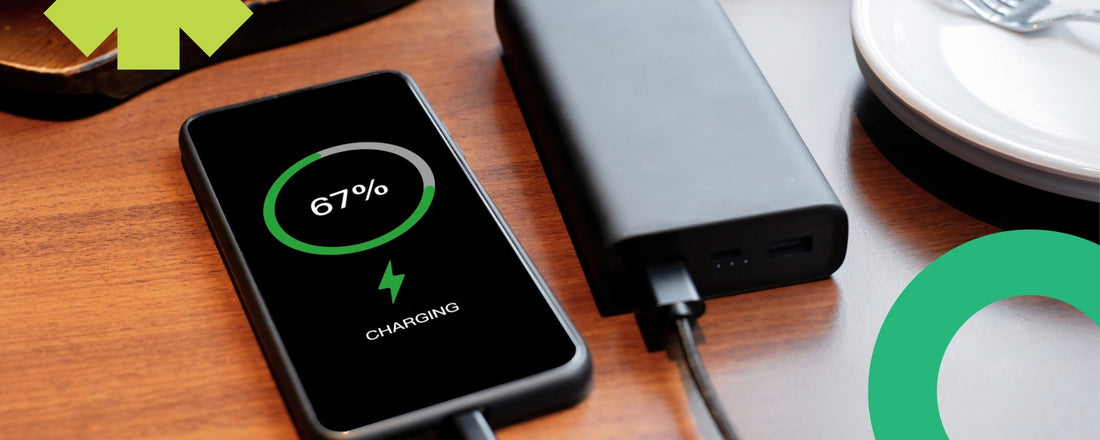Common Scenario 1: Power Bank Shuts Off While Charging Itself
One typical situation is when the power bank is being charged via a wall adapter, but it stops charging and shuts off after a short while. In this case, the only device connected is the charger. This behavior could point to several causes.
Start by verifying the charger itself. A wall adapter that delivers insufficient or unstable voltage will cause the power bank’s protection circuit to shut off charging. Try testing the charger with a smartphone to ensure it can deliver a reliable output. Additionally, check for loose connections. If the cable feels wobbly in the port, the connection may be incomplete, triggering a disconnect.
Dust or lint in the charging port can also interrupt proper contact. Cleaning the port gently with a soft brush or compressed air often solves the problem. Some power banks may also shut off automatically when they reach full charge. This is a safety feature to avoid overcharging. If the shut-off is consistent and repeatable after reaching 100%, it’s not a flaw—it’s protection.
Common Scenario 2: Power Bank Stops Charging Your Devices
Another common case is when the power bank is connected to a phone or tablet but shuts off after a brief period. This can be particularly confusing, especially when the device still needs to be charged. The reason could lie in the way power banks detect output demand.

Some electronics—such as wireless earbuds, smartwatches, or Bluetooth accessories—draw very little current while charging. If the power draw falls below a certain threshold, the power bank may assume nothing is connected and automatically shut off to preserve battery life. In this situation, a power bank with “low-current charging” or “trickle charging” mode is essential. This function allows the bank to stay on even with minimal power draw.
Another issue may be battery level. A nearly empty power bank may not have enough charge to support sustained output. Check the power indicator lights to confirm the bank still has usable energy.
Also, consider the condition of the charging cable and the ports. A loose or partially connected cable can break the flow of current and cause the device to disconnect. Clean connectors and avoid low-quality cables that degrade signal integrity.
Overheating is another important factor. If the power bank becomes too hot, thermal safety mechanisms can shut it down automatically. This is more common in fast-charging models or when using the bank in direct sunlight or high ambient temperatures.
Lastly, battery age and wear may be the root cause. Most lithium-ion power banks are rated for 500–1000 charge cycles. Once this limit is exceeded, battery efficiency declines, and the device may fail to hold or deliver power reliably. If your power bank is more than two years old and has seen frequent use, the issue may simply be natural battery degradation.
Software and Device Compatibility Factors
Occasionally, the problem lies not with the power bank but with the device being charged. Incompatible charging protocols or faulty internal circuitry on the receiving end can cause irregular power draw. Some smartphones or tablets may reject power input if they detect a mismatch in voltage or amperage levels.
There’s also the possibility of firmware-level conflicts. Some smart power banks include microcontrollers that manage charging logic. If a firmware error occurs, it may cause abnormal behavior. Restarting both the power bank and the device can sometimes resolve these conflicts. In rare cases, some manufacturers provide firmware update tools via USB, though this is more common with high-end products.
How to Reset Your Power Bank
Resetting the power bank can often resolve persistent disconnect issues. Methods vary between models, but common reset techniques include holding the power button for 10–15 seconds, fully draining the battery before recharging it, or inserting a pin into a small reset hole (if your model has one). Some banks automatically reset when fully recharged from empty.
Not all power banks support reset functionality. If your unit lacks this feature or continues to malfunction after reset attempts, it may indicate a deeper hardware failure.
Advanced Troubleshooting Techniques
If basic checks don’t resolve the issue, you may consider more technical methods, especially if the device is out of warranty.
One option is using a multimeter to test voltage and current output. This allows you to verify whether the bank is delivering the expected charge to your device. Significant variance from rated output suggests internal circuit problems. If you’re technically inclined, carefully opening the casing (not recommended for devices under warranty) may allow inspection for loose solder joints, corrosion, or physical damage such as battery swelling.

For smart power banks, check the manufacturer’s website to see if firmware updates are available. These can sometimes correct bugs that interfere with charging logic.
Environmental and Handling Considerations
Power banks are sensitive to environmental stress. Exposure to moisture, impact from drops, or prolonged high temperatures—such as being left on a sunny car dashboard—can cause permanent damage. If your power bank began malfunctioning after such an incident, internal components may have been compromised.
When to Replace Your Power Bank
If you’ve attempted all relevant troubleshooting steps, but your power bank continues to shut off or disconnect unexpectedly, the safest course is to stop using it. Malfunctioning lithium batteries carry safety risks, including short circuit and overheating.
Aging batteries, unstable circuitry, and inconsistent behavior are all valid reasons to retire a power bank. Replacing it with a well-tested, safety-certified model is the most reliable solution. Look for models that support low-current charging, offer clear power indicators, and have thermal and overload protection built in.
Some modern power banks, such as iWALK’s compact LinkPod series, integrate retractable cables, LED battery indicators, and PD fast charging, making them convenient for travel and everyday multitasking. While these models include many of the features discussed here, the most important takeaway is selecting a charger that matches your real-world usage, rather than just the highest capacity on paper.

Conclusion
A power bank that frequently disconnects can be frustrating, but it is rarely an unsolvable problem. From simple fixes like cleaning ports or replacing cables to more advanced checks using diagnostic tools, most users can restore their device to full functionality, or at least understand when it’s time to replace it.
Understanding your devices’ power requirements, recognizing signs of battery wear, and investing in quality components all help create a smoother, more reliable charging experience. As our dependence on mobile power grows, making informed, technically sound decisions becomes not just practical but essential.










